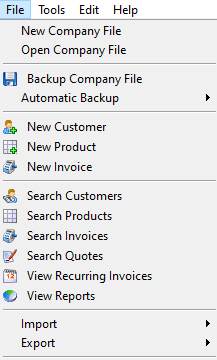Posey's Tips & Tricks
The Case for In-Application Backups
Application-integrated backup tools should never replace conventional backups, but they have their place.
As a freelance author and speaker, there are a number of applications I depend on to get the job done. At least two of these applications include options to create backups from inside the application. These options, an example of which you can see in Figure 1, provide an easy way to back up the data that's associated with the application.
Of course, such an option is not unique to these two applications. There are plenty of applications with built-in backup options. The question is, should you be using them?
 Figure 1: This application includes built-in backup options.
Figure 1: This application includes built-in backup options.
Assuming that an organization is backing up its data on a regular basis, there would seem to be little use for in-application backup tools. This is especially true given that such tools tend to be geared toward end users rather than admins. Even so, such tools have their place.
Let me give you a personal example. As with any other mission-critical application, it is absolutely necessary for me to always have access to the most recent data associated with the application shown in Figure 1 above. Because this is a desktop application, however, it stores its data locally on the desktop. As such, every time I use the application, I use an in-application backup to create a backup copy of the application's data. I use a file server as the backup target because the file server gets backed up by a continuous data-protection product.
In other words, this strategy gives me multilayer protection against a data-loss event. I am creating a backup of the backup.
But what about in-application backups for other types of applications? I'd be the first to admit that creating backups within applications might not be necessary if you already have a backup strategy in place, but there are some situations in which in-application backups might be beneficial.
One of the first situations that comes to mind is when an application does not support Microsoft's Volume Shadow Copy Service (VSS), thereby making the application difficult to back up. Such an application would have to be backed up at the file level. And if a file-level backup were to be created while the application is online, it's possible that the application's database contents could change while the backup is in progress, resulting in a corrupt backup.
Granted, in a perfect world, these types of poorly written applications would not exist in production environments. Even so, I have run across them from time to time.
Another use case for application-integrated backup features is making things more convenient for the end user. Many modern backup applications include features that allow users to restore their own data. Even so, some organizations are reluctant to give users the ability to restore data at will. An application-level restoration feature can be used as a tool to allow users to recover a very specific type of data if necessary, but without letting them recover other types of data.
One more potential use case for application-level backups is that they give users a way to create special backups. Last month, for example, I performed a major upgrade on my desktop computer. Since there is always the potential for something to go wrong during such an extensive process, I created an image-based backup of my PC, but I also created some application-level backups just in case. Ultimately, I didn't end up needing any of those backups, but knowing that I had multiple options for putting everything back to normal in the event that something bad happened was reassuring.
Of course, the average user isn't likely to be performing hardware upgrades on their corporate desktop. Even so, the concept of a special backup is still relevant. Back when I had a corporate job, I can recall the accounting department making special-purpose backups at the end of each quarter, and just prior to any upgrades to their accounting software.
The bottom line is that while I would never use an application-integrated backup feature as a replacement for a conventional backup, such features do have their place. They are probably best-used as a tool for supplementing the protection provided by your organization's primary backup solution.
About the Author
Brien Posey is a 22-time Microsoft MVP with decades of IT experience. As a freelance writer, Posey has written thousands of articles and contributed to several dozen books on a wide variety of IT topics. Prior to going freelance, Posey was a CIO for a national chain of hospitals and health care facilities. He has also served as a network administrator for some of the country's largest insurance companies and for the Department of Defense at Fort Knox. In addition to his continued work in IT, Posey has spent the last several years actively training as a commercial scientist-astronaut candidate in preparation to fly on a mission to study polar mesospheric clouds from space. You can follow his spaceflight training on his Web site.